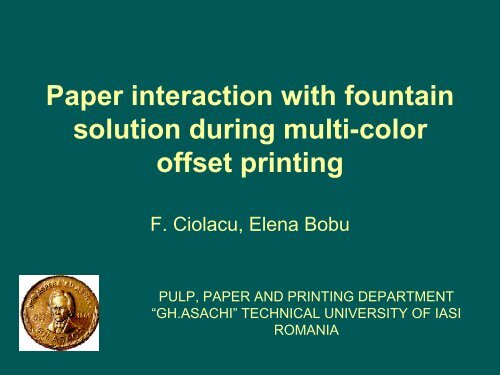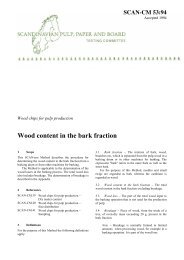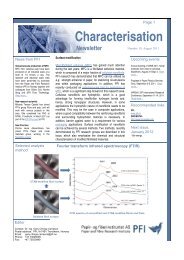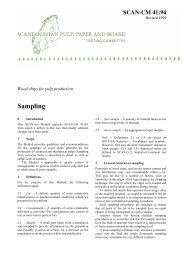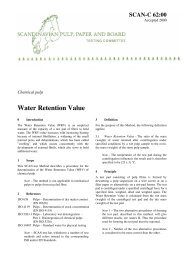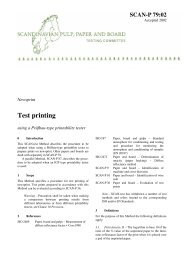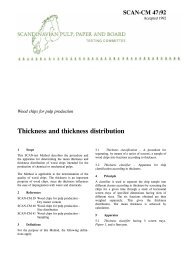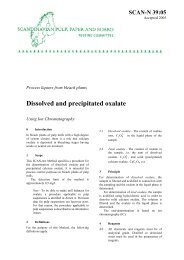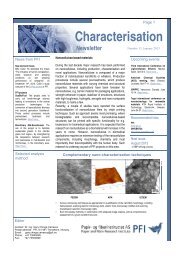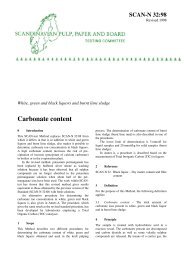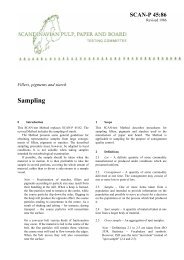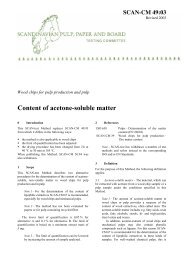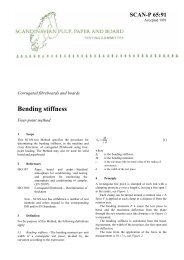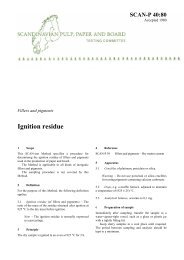Paper interaction with fountain solution during multi-color offset ... - PFI
Paper interaction with fountain solution during multi-color offset ... - PFI
Paper interaction with fountain solution during multi-color offset ... - PFI
You also want an ePaper? Increase the reach of your titles
YUMPU automatically turns print PDFs into web optimized ePapers that Google loves.
<strong>Paper</strong> <strong>interaction</strong> <strong>with</strong> <strong>fountain</strong><br />
<strong>solution</strong> <strong>during</strong> <strong>multi</strong>-<strong>color</strong><br />
<strong>offset</strong> printing<br />
F. Ciolacu, Elena Bobu<br />
PULP, PAPER AND PRINTING DEPARTMENT<br />
“GH.ASACHI” TECHNICAL UNIVERSITY OF IASI<br />
ROMANIA
Offset printing<br />
Printing Process 1991 1994 2000 2025<br />
Offset 47 46 42 25-35<br />
Digital, electronic 3 7 13 18-25<br />
Flexography 17 18 19 20-25<br />
Gravure 19 18 17 15-25<br />
Letterpress 11 8 6 4<br />
Silk screen 3 3 3 3<br />
• There are 5 main traditional printing processes and also the recent digital<br />
printing. Their characteristics largely determine the properties of the<br />
papers used.<br />
• The <strong>offset</strong> process has long been the leading print technology for<br />
economical production for high-quality medium and long print run.<br />
• Offset will remain the dominant production method, and this will be<br />
connected <strong>with</strong> an increasing digitization of the workflow and a spread of<br />
the computer to press/direct imaging technology.
Fountain <strong>solution</strong><br />
• A distinctive feature of <strong>offset</strong> printing plates is the fact that the<br />
printing and non-printing areas are on one level.<br />
• To separate these areas a very thin (approximately 2 µm) <strong>fountain</strong><br />
<strong>solution</strong> film is applied to the plate by the dampening unit.<br />
• Part of the <strong>fountain</strong> <strong>solution</strong> is<br />
printed, part emulsifies<br />
together <strong>with</strong> the ink, and part<br />
evaporates.
Fountain <strong>solution</strong>s generally consist of:<br />
A. Water - which comprises by far the largest portion of the <strong>fountain</strong><br />
<strong>solution</strong>.<br />
B. Acid - which reducing the pH, keeping the plate image area sensitive to<br />
ink as well as keeping the background areas sensitive to water<br />
C. Wetting agents - or surfactants lower the surface tension of the water<br />
allowing it to maintain the wetting characteristics of the non-printing<br />
areas (non-image areas) of the plate.<br />
D. Plate conditioners/additives - minimize the corrosive action of the acid<br />
on the aluminum plate.<br />
E. Gum arabic (gum substitutes- carboxymethyl cellulose) - serves to<br />
protect the plate from humidity and chemical attack <strong>during</strong> press<br />
stops.<br />
Isopropyl alcohol (IPA) was one of the most favorite<br />
wetting agents added!!
IPA in <strong>fountain</strong> <strong>solution</strong>s:<br />
• Reduces the surface tension of water, allowing water to wet the<br />
dampener form roller more evenly. The result is that less dampening<br />
<strong>solution</strong> is used and the water is spread more evenly to the plate from<br />
the rollers.<br />
• Increases viscosity to provide a thicker layer of dampening <strong>solution</strong> to<br />
be applied across the rollers, thereby improving the performance of<br />
the ink, paper and printing plates. Better, faster ink/water balance<br />
reduces waste from start-up.<br />
• Allows for less moisture to be carried to the paper, thereby causing<br />
less ink drying problems.<br />
In the past, and in some cases yet today, isopropyl<br />
alcohol was used in percentages as high as 20%.
Printing trends<br />
• An important printing trend is volatile organic compounds (VOC)<br />
reduction. Today this is required by legislation (VOC Directive on the<br />
Limitation of Volatile Organic Compound Emissions)<br />
• The environmental agencies have determined that IPA (isopropyl<br />
alcohol) is high in VOC’s (volatile organic compounds) and wants it<br />
eliminated from the pressroom.<br />
Alcohol substitutes have been developed to replace<br />
isopropyl alcohol!
Alcohol substitutes<br />
• Alcohol substitutes are all proprietary mixture of solvents. Even<br />
though alcohol substitutes are proprietary mixtures they do have a<br />
couple of common traits that should be considered:<br />
– First, they are very non-volatile and consequently a greater amount<br />
of <strong>fountain</strong> <strong>solution</strong> will be transferred on the paper surface.<br />
– Second, they are strong ink solvents.<br />
• Because of this combination of properties they tend to remain in the<br />
<strong>fountain</strong> <strong>solution</strong> and, at the same time, can extract some oil portions<br />
from the ink.
General Objective:<br />
To analyze the <strong>interaction</strong> of paper <strong>with</strong> <strong>fountain</strong><br />
<strong>solution</strong> (free of IPA) <strong>during</strong> <strong>multi</strong>-<strong>color</strong> <strong>offset</strong> printing<br />
Experimental approach:<br />
• Simulating and analyzing the transfer of <strong>fountain</strong> <strong>solution</strong> free<br />
of IPA on paper <strong>during</strong> <strong>multi</strong>-<strong>color</strong> <strong>offset</strong> printing<br />
• Analyzing the influence of softcalendering parameters (roll<br />
temperature and nip load ) on the printability of <strong>offset</strong> paper by<br />
measuring of print penetration of papers after repeated<br />
dampening
Experimental part<br />
Materials and experimental methods<br />
• Handsheets <strong>with</strong> basis weight of 80 g/m 2 were obtained on a Rapid-Köthen<br />
apparatus, using paperstock <strong>with</strong> a typical composition for fine printing paper:<br />
– Bleached hardwood/ softwood kraft pulps 70 /30 (30° SR)<br />
– 30% CaCO 3 (Hydrocarb HO from Omya)<br />
– 10 kg/t AKD (Aquapel 210 D - Hercules)<br />
• Each handsheet was calendered individually in one nip of a laboratory<br />
calender in conditions established by experimental program:<br />
Experimental program:<br />
Series<br />
Pressure,<br />
MPa<br />
Steel roll<br />
temperature, °C<br />
A 30 60<br />
B 20 150<br />
C 15 140<br />
D 25 125<br />
Laboratory calender features<br />
• Rolls: steel/soft-roll/steel<br />
• Roll diameter, mm: 250/195/195<br />
• Width, mm:350<br />
• Number of nips: 2<br />
• Maxim nip load, kN/m:380<br />
• Maxim steel roll temp. °C:200<br />
• Speed, m/min:30-60
Offset printing on IGT press<br />
• There are a <strong>multi</strong>tude of test print presses that find usage in practice.<br />
• With test-print presses special stresses on the paper and<br />
characteristics corresponding to the real printing process can be<br />
simulated. Under defined and reproducible conditions <strong>with</strong> low<br />
material consumption, test prints can be produced in the laboratory.<br />
• Printability test device IGT A 1-3 offers the possibility to study the<br />
<strong>interaction</strong> between printing ink and paper and to simulate the<br />
<strong>multi</strong>tude of influences of an <strong>offset</strong> printing press, also taking the<br />
dampening <strong>solution</strong> into account.<br />
• A commercial dampening <strong>solution</strong> “Litho Etch “ containing Mg(NO 3<br />
) 2<br />
and butyl Cellosove (Ethylene glycol butyl ether) as IPA substitute was<br />
used.
Fountain <strong>solution</strong> transfer<br />
Fountain <strong>solution</strong> transfer,<br />
g/m 2<br />
4<br />
3<br />
2<br />
1<br />
0<br />
IGT <strong>offset</strong> press<br />
2.7<br />
2.4<br />
2.5<br />
2.2<br />
1.8 1.9<br />
1.2<br />
0.9<br />
1 2 3 4<br />
Number of dampening<br />
• Dampening process was<br />
simulated on a IGT test print<br />
press and on a <strong>offset</strong> press of<br />
small format.<br />
• As compared <strong>with</strong> literature<br />
data a unexpected increased<br />
values for the <strong>fountain</strong><br />
<strong>solution</strong> free of IPA transfer<br />
was obtained ( 0.9-1.2 g/m2<br />
vs. 0.7-0.8 for the same<br />
conditions)<br />
Increasing of moisture<br />
content,%<br />
4<br />
3.5<br />
3<br />
2.5<br />
2<br />
1.5<br />
1<br />
0.5<br />
0<br />
2.37<br />
2.72<br />
1.91<br />
1.17<br />
1 2 3 4<br />
• <strong>Paper</strong> moisture content<br />
increased <strong>with</strong> 2.7%<br />
(absolute) <strong>during</strong> simulated<br />
<strong>offset</strong> printing on IGT press<br />
by repeating dampening<br />
operation four times<br />
Number of dampening
Surface roughening by <strong>fountain</strong> <strong>solution</strong><br />
Bekk smoothness, s<br />
Relative smoothness variation , %<br />
240<br />
210<br />
180<br />
150<br />
120<br />
90<br />
60<br />
30<br />
0<br />
24<br />
21<br />
18<br />
15<br />
12<br />
9<br />
6<br />
3<br />
0<br />
155<br />
22.38<br />
120<br />
60C 30MPa<br />
after dampening<br />
177<br />
158 163<br />
150<br />
150C<br />
20MPa<br />
10.65<br />
140C<br />
15MPa<br />
8.09<br />
189<br />
170<br />
125C<br />
25MPa<br />
10.05<br />
60C 30MPa 150C 20MPa 140C 15MPa 125C 25MPa<br />
• The effect of <strong>fountain</strong><br />
<strong>solution</strong> on the roughening<br />
of paper depends of the<br />
softcalendering conditions<br />
• Temperature had the largest<br />
effect, all samples<br />
softcalendered at the higher<br />
temperature had a higher<br />
smoothness after contact<br />
<strong>with</strong> water than the paper<br />
calendered at low<br />
temperature.<br />
• The best combination (low<br />
roughening) was found <strong>with</strong><br />
sample C, that is under<br />
conditions where the bulk of<br />
the sheet would be less<br />
affected: high temperature,<br />
low load.
Print penetration<br />
uncaledered<br />
60C 30MPa<br />
150C 20MPa<br />
125C 25MPa<br />
Print penetration<br />
40<br />
37<br />
34<br />
31<br />
28<br />
25<br />
22<br />
19<br />
16<br />
35.71<br />
31.11 30.30 30.77<br />
20.62 21.05 21.51 20.83<br />
1st 2nd 3rd 4th<br />
Print penetration<br />
24<br />
23<br />
22<br />
21<br />
20<br />
19<br />
18<br />
17<br />
16<br />
21.24 21.24<br />
20.13<br />
19.61<br />
18.43<br />
17.96 17.62<br />
17.09<br />
1st 2nd 3rd 4th<br />
Press unit<br />
Press unit<br />
Print Penetration<br />
24<br />
23<br />
22<br />
21<br />
20<br />
19<br />
18<br />
17<br />
16<br />
20.62<br />
19.35<br />
60C 30MPa 140C 15MPa<br />
• <strong>Paper</strong> samples that were<br />
23.09 calendered at high<br />
22.30<br />
21.51<br />
temperature and low<br />
21.05<br />
20.83<br />
19.72<br />
pressure <strong>with</strong> preserving<br />
bulk structure show a better<br />
stability on water action.<br />
1st 2nd 3rd 4th<br />
Press unit
Conclusion<br />
• The removal of the isopropyl alcohol from the<br />
<strong>fountain</strong> <strong>solution</strong> increases the quantity of water<br />
that is transferred on the paper.<br />
• The increasing of the <strong>fountain</strong> <strong>solution</strong> transferred<br />
leads to the amplification of the paper roughening<br />
phenomena<br />
• <strong>Paper</strong> samples that were calendered at high<br />
temperature and low pressure <strong>with</strong> preserving bulk<br />
structure show a better stability on water action.


